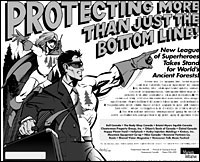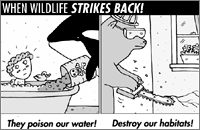Amanda Gibbs, a former radio and print reporter, is a senior associate with the Institute for Media, Policy and Civil Society, or IMPACS. Canada’s first nonprofit public relations and media training organization, IMPACS regularly works with large and small conservation and social justice groups to help “turn up the volume” on citizen action, participation, and debate.
Monday, 25 Sep 2000
VICTORIA, British Columbia
If it’s Monday, this must be Victoria. This motel room, though charming with its bolted-down television set and one-of-a-kind mallard watercolor print slung a bit too low over the double bed, isn’t feeling as exotic as it might have three weeks ago. You see, I’ve been on the road, a nine-community, whistle-stop tour of British Columbia delivering interactive workshops on message development, strategic media planning, and the power of great storytelling to dozens of nonprofits in this lovely, albeit bloody huge, province. Williams Lake, Prince George, Terrace, Smithers, Kelowna — we’re hitting them all.
My colleague and co-trainer Donna Barker and I have formed a new appreciation for the melancholy twang of truckin’ tunes (“six days on the road and I’m gonna make it home tonight!”) as have our patient lovers, friends, and wee kiddies waiting at home in Vancouver. However, all bellyachin’ aside, this tour has been a supremely rewarding one.

One of our rockin’ ads.
IMPACS, the organization I work for when I’m not raiding mini-bars or haunting hotel Tiki lounges, is the first full-service, nonprofit public relations and communications training organization in Canada. And one of our primary goals is to strengthen the communications skills of Canadian nonprofits — to help them successfully and economically communicate their messages. This means getting off our duffs and leaving urban centers for smaller communities that may not have access to media skills training. In fact, we’re card-carrying members of the Pacific Northwest Capacity Builders Network, an alliance of groups on both sides of the 49th parallel (yes, it is pronounced “oot” and not “out”) dedicated to providing workshop training to conservation groups throughout the region. In IMPACS’s case, our mandate includes more than just ENGOs (environmental non-governmental organizations), but you get the picture. We like to be with the people. We love to train.
What never ceases to floor me, however, is how creative, sophisticated, and “plugged-in” rural towns and communities are when it comes to media know-how. Most of the groups we’ve talked to can’t afford expensive billboards and print advertising to get their messages out, so they get extra savvy about gaining “earned media” coverage in their local papers and radio stations. They form strong relationships with friendly reporters. They develop innovative events that get entire communities out and schlepping pledges. And they write letters to the editor and opinion pieces with aplomb. What we do is provide them with some strategic tools, share our experiences, offer some new tactics and templates, and encourage networking and relationship building among participants.
After one of our initial workshops on this tour, a group of participants formed an editorial committee. They planned to meet regularly to brainstorm around campaign strategy and potential media hooks. The folks in this circle represented women’s centers, conservation and parks boards, mental health advocates, and child and youth serving orgs, but they were able to build an alliance that seemed to transcend the differences in their issue areas. They rocked the house and taught me a lifetime of lessons about the value of building consensus, support, and networks outside your perceived area of comfort or interest.
For those of you with more prurient tastes, I’ve got to hop in the shower this morning and grab a boot-to-the-head espresso for courage. I’m lead trainer on “Be the Word on the Street,” a message development workshop that asks me and everyone in the session to act like hopped-up ad execs for six or so hours. Fun but exhausting, and frankly a bit sweaty.
But enough about me. If you are looking for some news and facts you can use, check out our website. More on web activism and writing ad copy for the angels tomorrow.
Tuesday, 26 Sep 2000
VICTORIA, British Columbia
When I left off yesterday morning, I was about to jump in the hotel shower. I won’t go there except to say that I didn’t slip in the tub — mission accomplished. Oh, the life of a media campaigner/trainer — so glam, so fab.
Once clean, my next order of business was to train 30 folks in the art and science of message development. By the end of the day, all assembled had designed the concepts for funky billboards intended to reach the strategic goals and communicate the messages they honed during the day-long session. Initially wary of getting too lighthearted about serious topics, the group ended up sketching out and pitching some superb “issue advertising.” They morphed into the cast of Thirtysomething (for those of you without a love for pop trivia, this was an ’80s television show about characters who work at an ad agency) before my eyes, designing killer campaigns, brainstorming around cultural trends, and piggybacking on mainstream culture. They seemed to enjoy the opportunity to step outside their comfort zones and get both tactical and creative. I’d share some of their work, but they tell me it’s copyrighted. Smarty-pants!
I’m glad they came around because issue advertising has become a powerful campaign tool — a means of going directly to your audience and sidestepping a dependence on mainstream media coverage.

Extinction sucks, but this ad doesn’t.
When I’m back in the home office in Vancouver, I end up working on a good deal of issue advertising in support of some fascinating public campaigns. For instance, IMPACS collaborated on some great ads with the lovely and talented Kate Smallwood, a former Grist diarist and the director of the British Columbia Endangered Species Coalition.
Kate wanted to develop a campaign that could reach a new audience with an urgent message about the need for endangered species legislation in Canada and in B.C., one of the most bio-diverse regions on the planet. Youth (ages 18 to 35) were not active on this issue, though opinion research had pointed to their interest and support of species protection. Through a process of brainstorming, sugar overload, booze, focus-group testing (formal and informal), and serious trial and error, we came up with a message and a visual that reflected the slightly cynical yet socially engaged energy of this slice of the demographic pie. The message: extinction sucks. The concept: a catalogue that details how vital species are being sold out. The central image: a Killer Whale on a soap box. The call to action: tell a decision-maker you want to see legislative change. The viral effect: create a buzz among taste-makers and opinion leaders. We also worked with an award-winning illustrator, Mia Hansen, to come up with a comic strip we could place in magazines and newspapers across Canada. You can see the results and send a free fax to a Canadian decision-maker in support of strong endangered species legislation at the Extinction Sucks website.

Part of a comic strip by Mia Hansen.
These types of ad campaigns have their detractors. There is worry that they mimic too closely the aesthetic and ethics of commercial advertising. There is fear that issues are being turned into products and brands and are losing their grassroots appeal. Maybe. But the reality is that nonprofits are having to compete in an incredibly vibrant, cutthroat, competitive, rapid-paced media universe. The public has become too familiar with the images conservation and social justice groups have used in the past. We need to surprise, unsettle, and engage our audiences. Only then can we inform and educate. And why back down from a rumble — we can’t afford to miss mixing it up in this hurly-burly marketplace of ideas.

Enviro ads get a sexy new look.
And since I have been given this lovely Gristly soapbox, I’ll run with it. I happen to believe that for all its many limitations, pop culture is an excellent tool for communicating to large audiences. It is accessible. It registers in the brain stem. And nonprofits need to reach new, persuadable audiences. This doesn’t mean jettisoning your tried and true messages in favor of sexy new ones. Nor does it mean alienating the constituencies that form your base of support. It means becoming a cultural detective to root out the most radical, attention-grabbing way of making your urgent information real for new audiences. What are their core values? Read what your target audience is reading. Visit their favorite websites, and yes, watch their favorite crappy TV show. Find out what makes them laugh. It’s all research.
California’s Public Media Center has pioneered issue advertising techniques over the last 20 years, but this type of approach is still relatively new to most countries outside the U.S. Vancouver’s Adbusters Media Foundation has used stunning parodies of mainstream advertising to ramp up public campaigns on the environment, anti-globalization, and genetically modified food.
I think it would be great to find myself out of a job. This isn’t slack, but just the desire to see nonprofits building the capacity to do these kinds of campaigns in-house. You know your issue better than anyone. You know the language and the jokes. This process can be incredibly energizing and a fun antidote to paper pushing. Believe me, you’ll feel like a spy in the house of advertising.
My head hurts. I think I need coffee and danish pronto. Sorry I didn’t describe more of the features in my hotel room this morning, but they’ve blended into a pastel haze of melamine counters and yucky white towels.
Tomorrow: Why we should all start a magazine like Grist.
Wednesday, 27 Sep 2000
VICTORIA, British Columbia
Good day. You know, I am taking this daily journal writing very seriously. I could cheat and prepare an entry weeks in advance, agonizing over each phrase, but here I sit doing it real time. It’s 6:00 a.m. and I’m writing like my head’s on fire so I can eat some breakfast before my next day of workshop delivery. I wanted to give you the true flavor of my day. (This martyr also went out for dinner last night instead of slaving away at the keyboard in her room.) Normally I would confide my thoughts to my pink Hello Kitty diary with the teensy key, but instead I have dumped, uploaded, shared, and kvetched with the fine folks at Grist.
I first heard about Grist in a rather unusual way. Last Spring, IMPACS was featured in a front-page story in our largest daily newspaper, the Vancouver Sun. A special report for Earth Day, the piece focussed on the issue advertising campaign I discussed in yesterday’s journal entry — www.extinctionsucks.org (click, click, save a marmot quick!). The hook: Enviros have discovered irony. Grist was also featured as an example of an ironic, smart-assed new generation of conservationists. Interesting premise.
I guess the idea is that the general public views environmentalists as rather dour, angry types. You know, grouches in hemp clothing, deprived of Vitamin B12 thanks to their largely vegan diets. They’re people whose earnest approach to saving the planet prevents them from having a chuckle at their own or others’ expense.
Now if I use my dining partners last evening as a test case, this stereotype doesn’t stand up. Valerie Langer from Friends of Clayoquot Sound in Tofino, Nicole Rycroft from the Markets Initiative, and Mark Price from the Natural Resources Defense Council joined my co-trainer Donna Barker and I for dinner last night. We were laughing so hard by the end of our meal that Nicole appeared to be blowing beet juice out her nose. We were having a great time talking about travel, food, weight gain, languages, black velvet paintings, Star Trek, and very little about work. We were a virtual cabal of ironists. We were like Dorothy Parker’s literary set of wits at the Algonquin Hotel in the ’20s. Well, that could be a stretch, but the conversation and the company were gregarious and funny.
I had a meeting with a client yesterday that shed some more light on this question. IMPACS is working with International Physicians for the Prevention of Nuclear War on a public campaign intended to reach a new audience with a message about peace and disarmament. Since the ’80s and the fall of the Berlin Wall, the issue has all but disappeared from public debate. IPPNW and its affiliates want to galvanize a new generation of activists dedicated to the prevention of nuclear war. (Find out more at the IPPNW website.)
Dr. Mary-Wynne Ashford, the vice president of this organization, lives and works in Victoria, so we decided to meet and talk about the campaign. We are looking at several approaches — some humorous, some more scary. Dr. Ashford commented that she did see a lot of humor (tons of sexual innuendo) used in the campaigns of the ’70s and ’80s. She didn’t feel that this was anything new — the jokes just needed to be reframed for a new audience. However, when she read some recent comments from a focus group (ages 18-35) on the issue of nukes and the campaign messages we were preparing, she got worried. It was the cynicism and emotional distance from the issue that struck her. I tended to agree. It could be stating the obvious to say that pervasive irony means we’re becoming disengaged from a sense of belonging, of stewardship, of connecting with bigger issues like, say, global survival.
Now in the wake of the Vancouver Sun’s irony piece, I am seeing articles in the mainstream press about “the new sincerity,” heralding a return to a more earnest approach to the world. Trend makers say get rid of your practiced sneer, and no more bitchy cynicism. I’m not sure where I register in this discussion. I’d probably opt for some bumper-sticker-style slogans. Irony with a soul. Humor that doesn’t dampen political goals. And definitely beet juice shot out of the nose over dinner.
Thursday, 28 Sep 2000
VANCOUVER, British Columbia
I arrived back at home base in Vancouver late last night and for the time being my travels throughout this lovely province are over. IMPACS still has three communities in northern British Columbia left to visit, so I now pass the media skills training torch to my colleague, Suzanne Hawkes. I’ve thoroughly enjoyed this tour, but the wind is starting to go out of my sails. As you may have guessed from my punchy dispatches, I’m getting a mite tired. Suzanne, an experienced campaigner and educator, is a dynamic, some might say thrill
ing, trainer who can hold huge groups in thrall for days on end. All I can say is the folks in Terrace, Trail, and Smithers are in for a treat.
Travel has become a huge part of the work we do at IMPACS. I work in the Communications Centre that serves Canada, but our organization also works internationally to foster the development of free, critical, and effective media worldwide. Shauna Sylvester, one of IMPACS’s founders and currently our executive director, has been developing partnerships that promote the role of media development in peace-building and work to provide media training and support to countries in transition to democracy.
Peace-building — in war-torn countries around the globe — means strengthening the prospects for peace and weakening the chances of renewed violence, to enhance the capacity of a society to manage its own conflicts.
Yet almost all peace-building efforts take place in a highly charged and unstable media environment, one in which information is scarce and often suspect. So there is an early and crucial role for the media to play in this process. If the media on the ground continues spewing out half-truths, propaganda, and poor information, it can’t help but hurt other diplomatic and political efforts. But if the media can play a role in expanding debate and disseminating accurate information, it has a major role to play in creating peace.
An example of this type of project is IMPACS’s collaboration with Cambodian journalists. IMPACS has monitored the media situation in Cambodia since 1997, and in 1998, one week after Cambodia’s general elections, IMPACS assessed the potential for a Canadian-sponsored journalists’ training project in the country.
In Cambodia, where the post-conflict peace-building process is tenuous, the media can play either a constructive role in providing balance and expression to a diversity of views, or it can be inflammatory, deepening existing divisions. For the most part, the Cambodian media leans towards the latter — it is highly subjective and politically fractious.
After interviewing local journalists and agencies, IMPACS determined that there was clearly strong interest in a post-election media development initiative, and the Cambodia Journalists Training Project was born.
Launched in September 1999, the project is funded by the Peacebuilding Fund of the Canadian International Development Agency and will finish its operations this December. Together with three local partner groups, the Women’s Media Centre, the Cambodian Communications Institute, and the Council for Journalists Training at the Royal University of Phnom Penh, IMPACS brings experienced journalists and trainers from Canada to conduct courses with more than a dozen radio stations and journalism schools throughout Cambodia.
Interestingly, radio reaches more people in Cambodia than any other medium. Newspapers do not circulate beyond Phnom Penh city limits. Television is in its infancy in the country, and is still beyond the means of millions of rural Cambodians. Radio, however, reaches every province, whether through provincial stations, relay transmitters, or in some cases loudspeakers in the marketplace!
I’ve been corresponding with the journalists who coordinate the project, Wayne Sharpe of Canada and Ouk Kim Seng of Cambodia, about volunteering in Phnom Penh next month. This isn’t work-related, it’s actually my holiday, but I can’t pass up an opportunity to visit what from all accounts is a fascinating country. It looks like I’ll spend a day offering a strategic media skills workshop to local NGOs and the rest of my time volunteering, touring around the country, and working on some freelance journalism of my own. (If you’d like more information about IMPACS’s projects, you can check our website or send us a query at media@impacs.org.)
Now to book my flights, get my shots, and plan an itinerary. Hey, I know I’ve just mentioned some mild burnout, but in this case I know that a change is definitely going to be as good as a rest.
Friday, 29 Sep 2000
VANCOUVER, British Columbia
I think I’m having a moment. I’ve never met the voyeuristic team that edits these intimate, at times painful, diary entries, but I’m going to miss you folks. I know you’re there. Like that mole on the middle of my back I will never be flexible enough to see, I feel you with me. Okay, clearly I’m tired, what can I tell you about the butt-end of this week …
To recap: I delivered two workshops and discussed the need for media skills capacity building. I talked about issue advertising and how to become an ad exec for the angels. I tried to debunk the stereotype of the humorless enviro activist by telling tales about a messy dinner partner. And finally, I regaled you with some information about the post-conflict region — Cambodia — where I hope to take a working holiday next month. (I thought that might be marginally more interesting than narrating my excavation into the 300 emails that were waiting for me back at the office on Thursday morning. Zoinks!)

Another of our rockin’ ads.
Today I’d like to discuss websites that don’t suck. IMPACS tries to help nonprofits develop websites that work in concert with their strategic communications goals. We help them survey potential users for guidance on the best structure and content. We recommend they heed the advice of web guru Jakob Neilsen and forgo dancing elf animations. We push clients to think of their website not as the gravy on mashed potatoes, but as the protein or carb — one of the basics in their communications outreach. (Overwrought metaphors aside, wassup with these low-carb diets? They make me faint and sweat. Can this be good?) We try to put together a combination of web activism, paid advertising, and mainstream media attention to draw new audiences to their issues.
Recently, we worked with Chris Tollefson at the University of Victoria Environmental Law Centre to design a web strategy for a citizen’s action site on clean air issues. We heard clearly from potential users that they wanted something simple with hard data they could use. Chris and his team merged the site launch with a book launch and some extensive media outreach. All the moving parts came together feeding and fuelling the others. This is the way web strategy is supposed to work. We encourage groups to think about the web as an interactive tool for building a relationship with their audiences — potential volunteers, voters, and activists.
But there is one critical thing that we’re not doing on the web front — taking our own advice.
Today and Monday, I’ll be sitting down with a crack team of staffers to rethink, nay, completely reinvent our current web strategy. We have been so busy in our first three years of operation that we have not had as much time as we’d like to spend on our own materials, especially the web. And we’re becoming like the aunt who lectures you about smoking while reaching for her second pack of Marlboros.
This afternoon our crack team (heh, heh) will address the need to build a stronger interactive relationship with our audience — giving them an opportunity to offer feedback or comments via a bulletin board and giving us an opportunity to fire off issue updates or reminders about workshops via a listserv. We need to think about online fundraising, as we are also a nonprofit. The latest stats available tell us that with a strong fundraising program, we could raise one dollar for every 100 visitors. And we also need to think about redesigning the user interface, making the data road map much clearer and easier to use.
I guess it’s a common probl
em. We spend so much time working with others that we forget about what’s happening at “home.” (Not-so-subliminal message to husband — peace out, I’m back in the crib for a while, homey.) So I’m looking forward to the challenge in a Dr. Frankenstein-ish kind of way. We can rebuild the monster using all the component parts we’ve recommended to other nonprofits. We can save face with our partners and give life to website that doesn’t suck.
To end my exhausting week on a life-affirming note, this weekend I’m taking a ferry to Vancouver Island again to visit my new red-haired nephew, Aidan Michael Christopher Gibbs-Webber, born yesterday morning and weighing in at nine-ish pounds (ouch, sis!).
Thanks for the soapbox, Grist. In the words of B.C.’s coolest web campaigner, Kate Smallwood, “You rock!” Take it easy and if you have any comments or would like to chat about any of the scintillating topics I’ve visited this week, please don’t hesitate to e-mail me at asgibbs@canada.com.


